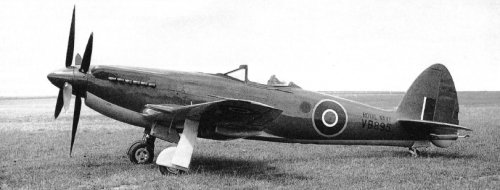I have a copy of the P24 spec for the moderately supercharged engine:
Summarising it specifies
rated power: 1,500 bhp @ 2,600 rpm
max Take off power: 1,540 bhp @ 2,300 rpm
rated altitude: 9,500 feet
normal rpm: 2,600 rpm not normally exceeded for continuous cruising at any altitude.
max permissible rpm: 3,000 not to be used for more 5 minutes consecutive running.
diving rpm: 3,150 rpm at not more than 1/3rd throttle opening.
max permissible boost: +3 lbs/sq in.(for not more than 5 mins)
rated boost: +2lbs/sq in.
fuel: DTD 230 [ I think is 87 octane]
bore: 5.25"
stroke: 6.0"
capacity: 3118 cu. in (51 litre)
The flight engine rating data is:
rated altitude: 10,000ft
rated boost: +1/2 lb/sq in
max permissible boost: +3 lb/sq in
normal rpm: 2,400
take off rpm: 2,
bhp @ 2,400 rpm @ 10,000 ft - 1,275
bhp @ 2,750 rpm @ 10,000 ft - 1,425
bhp @ 2,130 rpm @ +3 lb/sq in boost - 1,300
-------------------
A G Forsythe refers to 5 hours running at 2,000 to 2,300 bhp and 20 hours at 2,000 to 2,100 bhp.; I guess these must be the results from test bed running at high boost and/or 100 octane fuel.
In 'Rod' Banks book ' I kept no Diary' he refers to " Fairey's [D12] initiative stirred things up and one result was the Rolls-Royce Kestrel..... Later put in hand the design of a vertical H type, liquid-cooled, poppet valve, double crankshaft (unconnected) engine, each shaft driving one half of a contra-rotating propeller - rather on the lines of the Zerbi Fiat racing engine. Graham Forsythe had the design responsibility and engineering development of this 1,800 bhp engine, the Prince, and I helped him with advice on valve and piston design. But the engine received no support from the Air Ministry, perhaps rightly so in view of the number of engine manufacturers already existing, though in my opinion, it had the makings of a reliable high-power unit."




